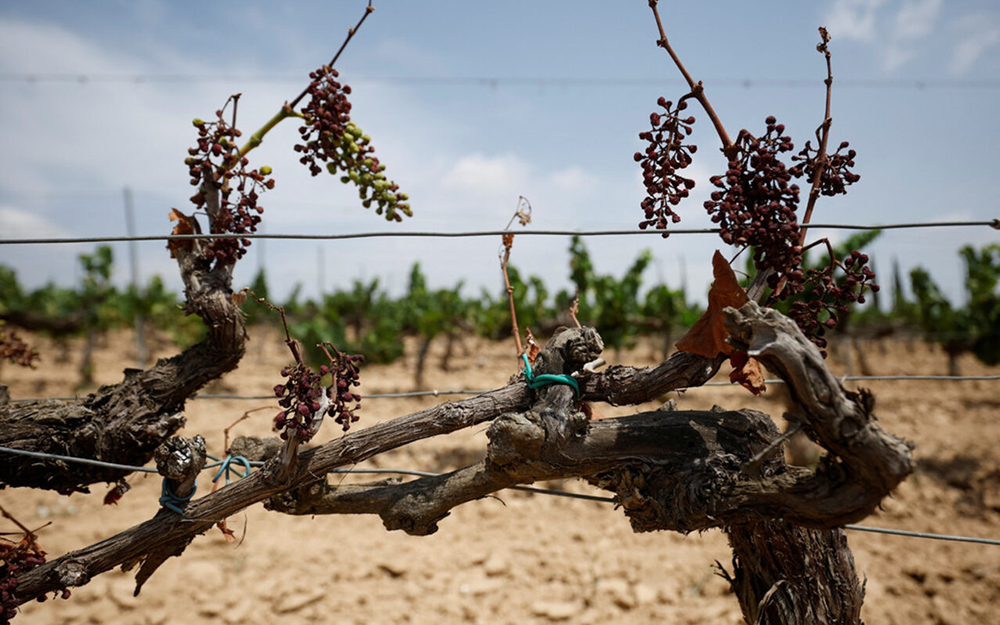
By Rick Riozza
Indeed—precipitation has left el edificio—the building.
Right now, Spain is suffering from one of the worst droughts since the ‘60s and it’s affecting the vineyards big time.
Climate change has left parts of the Iberian peninsula at their driest in 1,200 years, according to a studyin the Nature Geoscience journal. Spain has suffered three unusually long heatwaves this summer that have stoked devastating wildfires.
Spain will produce its smallest vintage in six years after adverse weather hit major growing areas, with volumes forecast to fall 20% to about 33m hectolitres, industry group Cooperativas Agro-Alimentarias Castilla-La Mancha said.
Although grapes grew abundantly, the dry heat made them less juicy, and it is reported that without the use of chemical fertilizers, for the best results the grapes need to develop at a gradual pace from when they form on the vine to when they are harvested, but of late, the weather has fast-tracked that process, to detrimental effect.
Isaac Muga Palacín, of Bodegas Muga in Rioja, says that Spain’s most well-known wine region has not escaped the onslaught of heat over the past few years. “In the history of Rioja, there have always been years of drought; but with the intensity of these last two years, [this] is something never seen before,”
Rioja faced not only extreme heat through August and September but also tumultuous rains later in September. This one-two punch caused many of the vineyards that were already struggling to sustain their grapes to then grapple with mold and rot because of the unexpected moisture. Generally, Spanish production is seen falling 14% to a 20-year low as the result of a severe drought.
Although climate change has caused chaos in the wine industry in Rioja, Muga and his team have found a thin silver lining. They noticed that the vineyards stationed in higher altitudes of Rioja Alta were able to retain more water, producing higher-quality grapes. Of course, what that means is that the price of world class Rioja will be up there.
Now as you wine nerds know, there is a school of thought that over the long run, drier conditions will actually improve the quality of wines. The vines themselves will grow deeper, more expansive root networks as they search for groundwater. The skins of the grapes will thicken, and the flavor and sweetness will concentrate.
And, some vignerons and viticulturists have been practicing dry farming for a while now and have been met with good results. But even these growers admit that the short-term effects are problematic.
While many contend that some water stress can be good for grapes, these prolonged droughts can have more consequential ramifications. A small amount of water stress may help grapes become sweeter by concentrating flavors. But drought stunts the growth of the shoots and vines, and, ultimately, leads to lighter yields. This decrease in tonnage from vineyards directly impacts supply which leads to a comparative wine scarcity when it’s time for those vintages to come onto the market.
The Rioja wine region of Spain is in the north and a couple of hundred miles south of Bordeaux—it’s where the famous bull-run city of Pamplona is located. The red Rioja grape is named Tempranillo—and those that know a bit of Spanish, are aware that temprano—means early. And the Tempranillo grape ripens early. Back in history, when Bordeaux had a weak vintage, they went south to Rioja to grab some of the early wine to buck-up theirs.
Rioja red wine classically brings notes of blackberries, cassis, black cherries, earth, leather, plums, and spices.
In view of the drought, one may wish to pick-up a nice Rioja here or there. Here are some recommendations:
Great Rioja can be grabbed at around $30 to $50 bucks. A very good table Rioja can be found at really low prices—see what’s selling at Trader Joes!
But let’s showcase a magnificent world class wine: 2019 Bodegas Sierra Cantabria Rioja Amancio ($200). “A rich, full bodied red in a sculpted, harmonious package, this shows a generous range of blackberry paste and black cherry reduction flavors, with aromatic accents of tar, tea rose, melted licorice, eucalyptus, and graphite. Bright and silky as this glides on the palate, expanding through a lasting finish firmed by fine-grained tannins.” 95 points, Wine Spectator
Wine Enthusiast writes: “Deep violet-red to the eye, this wine has aromas of blackberry, cedar chest and olive tapenade. Muscular tannins frame cassis, purple- plum, dark-chocolate, lavender and dried thyme flavors. A bright cherry note endures on the palate.”
An excellent wine at a wonderful price for the quality is: 2019 Bodegas Izadi Rioja Reserva ($22). “Well-balanced and silky on the palate, this classy red features a beam of ripe mulberry fruit, with creamy tannins and aromatic hints of dried flowers, crushed pine, and sandalwood, followed by a plush finish.” WS
Another extremely well price wine is the 2019 Bodegas Altanza Rioja Crianza at only $19. “Zesty and herbaceaous, this fresh red is medium bodied, with flavors of macerated cherry, singed orange peel, game, eucalptus, and Mediterranean herbs framed by light crunchy tannins.” Cheers!
Rick is your somm-about-town tasting wine at many local venues. If you’d like him to write about one of your favorite under-the-radar wine haunts, contact him at winespectrum@aol.com










































